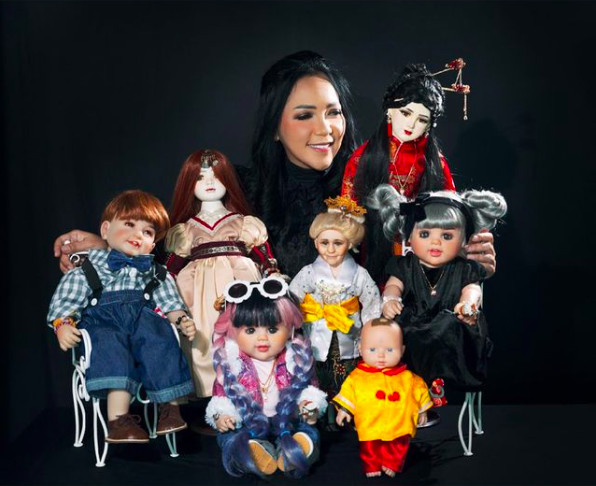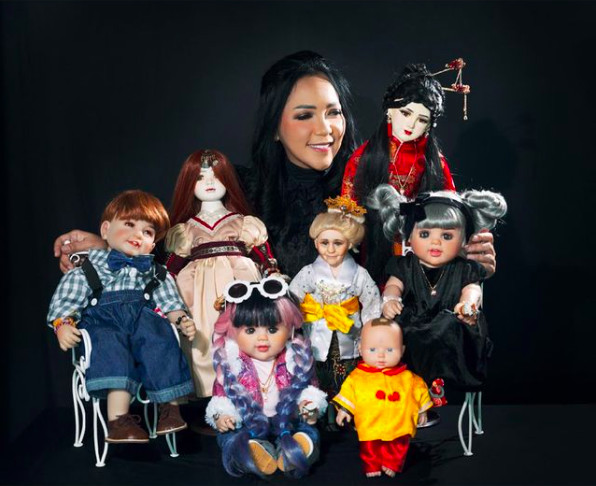Spirit doll craze: Just a trend, or something else?
Change text size
Gift Premium Articles
to Anyone

T
he sudden boom in collecting spirit dolls among local celebrities may confound many, but two experts offer their scientific insights on what could be behind the trend.
The trend in collecting spirit dolls was apparently started by collector Furi Harun, who has more than 300 such dolls in her collection, a trend that has recently grown into a craze among Indonesian celebrities. The self-proclaimed “indigo child” also sells the dolls under her Instagram handle @bonekafuriharun.
While definitions vary, spirit dolls are said to embody a spirit or supernatural power, or a vessel that channels them. They are also known as medicine dolls or healing dolls, and are part of many ancient world cultures. On the other end of the spectrum, they are said to be possessed, like Annabelle, made infamous in horror flicks like The Conjuring and her own namesake feature movie.
Furi is also reportedly the one who supplied spirit dolls to fashion designer Ivan "Igun" Gunawan and other celebrities.
Ivan faced online scrutiny after he introduced two dolls, named “Miracle Putra Gunawan” and “Marvelous Putra Gunawan”, as his “baby boys” to his friend Boy William in an episode of Boy’s popular YouTube talk show.

In a Q&A video on her YouTube channel, Furi claimed that spirit dolls were possessed by spirits who needed love and affection just like children. The spirits, she believed, were those of dead babies or aborted fetuses that were roaming the earthly plane and needed their “parents” to guide and pray for their safe return to God.
Spirit doll “parents” should fulfill the dolls’ needs just like they would for babies and little children. These “parents” should feed the dolls by presenting food and drink in offerings placed before the dolls. Furi said that the spirit dwelling within a doll needed to eat and drink, just like living human children.
She also stressed that spirit doll “parents” should give psychological support to their dolls, not just love and affection. “Parents” should also apologize to the dolls if they made mistakes, like getting angry at them or dropping them.
Although many Indonesians might cringe at the craze, our Thai neighbors seem to be more accepting of spirit doll enthusiasts.
Spirit dolls are known in Thailand as luk thep, which means “child angels”. Believed to channel good spirits that will bring luck and fortune, luk thep are treated and care for like babies. Their “parents” bring the dolls with them everywhere they go, and apparently it is normal for these “parents” to buy an extra airplane seat for a doll or ask for an extra chair for them at restaurants and salons.
Paradox
Sociologist Robertus Robet views the local phenomenon as indicative of a sense of disassociation among the middle class. Instead of dealing directly with their problems, these people are actually expressing their problems and aspirations through an inanimate object.
“Spirit dolls are objects used as a means to express various [things], such as desire, fantasies and complaints against reality,” said Robertus. “The spirit doll phenomenon is a paradox. A spirit doll is an inanimate object, but it is treated just like a living person.”

He also said that “adopting” a spirit doll gave the “parent” a channel for having control over something.
“Imagining a spirit doll as a child is radicalizing its [function] as an object, as well as the adult desire for control. It is controlled and used as an object of fantasy,” he said.
'It's a baby'
"It's a baby. I treat him like a baby," Ivan tells Boy, who is holding “Miracle” in his arms during the YouTube talk show.
Ivan also tells Boy that the dolls “sleep” in cribs. He says he also takes “his babies” to malls and other public places and dresses them in selected outfits (fancy ones for going out, comfy ones for lounging at home).
He talks to them and cares for them as if they were real babies, and believes that they will grow into full-grown adults, just like human babies.
“I am fine. I am not crazy. Many people say I’m stressed, I’m imagining things, but I am not,” Ivan insists.
Ivan’s “Miracle” and “Marvelous” were later identified as spirit dolls. The dolls themselves were manufactured from porcelain or soft materials like plastic or silicone and designed to resemble the look of real human babies.

It is unknown whether the YouTube show was scripted or not. Nevertheless, it ignited public debate over the spirit doll phenomenon among local celebrities. By the afternoon of Jan. 6, more than 65,000 tweets about spirit dolls had appeared in Indonesia’s Twitter timeline, most of which responded to the phenomenon satirically or with sarcasm.
Desire
Psychologist Kasandra Putranto said that products that possess romance, mystery or cultural values could generate strong desire in potential consumers.
“For example, a tourist spot attracts tourists not only because the landscape is beautiful, but also because it has magical, nostalgic, or romantic properties,” said Kasandra.
These narratives intended to create higher economic value could also apply to spirit dolls, she added. They could also apply to other consumer products like clothing, accessories and decorative items like the kris dagger and batu akik, gemstones believed to have healing or protective powers.
In the case of spirit dolls, Kasandra said there are many reasons why people treated them like living babies.
“Some use the dolls for therapy, as an object of love or to bring them joy. Some believe that the dolls bring good luck. The others just create narratives to increase sales,” she said.
Jovita Maria Ferliana, a psychologist focusing on children, teenagers and family psychology, said playing with dolls was a normal activity for young children to express their imagination.
“Children 2 to 8 years old commonly talk to their dolls, taking them to eat or for a stroll, and it is a good development [opportunity] for children, as toys can be used to express imagination, fantasy and creativity,” she told the Post on Friday.
“However, for adults, taking care of dolls can be seen as a manifestation of an incomplete self,” she continued. “Seeing dolls as your own children or family members might be a manifestation of the need to give and take love. It is normal, but the person should be able to differentiate reality from fantasy.”
“If that person can no longer differentiate reality from fantasy, for example, believing that the doll can talk, the doll can eat on its own, that the doll orders its owner to do things, that person should consult a psychologist or a psychiatrist,” Jovita said.









